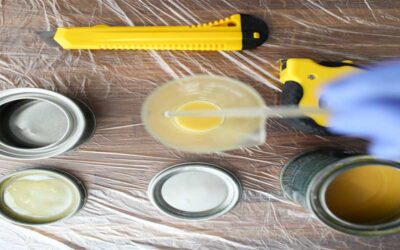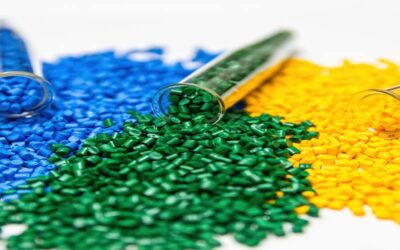Acrylic resin has excellent features such as transparency and durability. These resins are used in various applications. From consumer goods like lenses to industrial goods like molding materials, coatings, and adhesives are made from acrylic resin.
Moreover, this resin is also used in other areas. For Examples; PC screens, fiber processing, binders for paper, display windows for cellular phones, and light guide panels for liquid crystal display backlights.
Acrylic resin is used extensively in various applications including automotive, architectural, and plastic coatings due to its excellent weather ability as a coating material.
Let’s learn what is Acrylic Resin, its Definition, Properties, Function, History, Types, Advantages, Disadvantages, and the difference between Epoxy Resin and Acrylic Resin.
Acrylic Resin Definition
Acrylic resin is a thermoplastic or thermosetting plastic component derived from acrylic acid, methacrylic acid, or other related compounds.
It makes a crosslinked polymer if treated with polyisocyanates. These materials are very useful components in some paints.
It is used in paints, coatings, and adhesives, fabrics, textile and leather finishes, windows and clear glazing, mounts, and display cases.
Properties of Acrylic Resin
Acrylic resins have some very useful characteristics. Some of which are:
- Highly transparent
- Weather resistance
- Transparency
- Heat resistance
- Hardness
- Water resistance
- Resistant to deterioration and
- Come in higher thicknesses
- Resistant to UV
- Unbreakable
- Sturdy
- Appearance (gloss, build)
- Chemical resistance
- Workability
- Adhesion
These characteristics and properties make acrylic resins a feasible material.
The Function of Acrylic Resin
Coatings utilizing acrylic resins are the prominent polymer technology in the coatings industry.
Alkyd finishes have held the leading position in coatings for ages. Acrylics are commonly used in architectural coatings, product finishes for original equipment manufacturers including automotive (OEM), and refinish.
This is also used for special-purpose coatings.
- Solvent-based acrylic resin and waterborne acrylic resin are commonly used as coating materials in different industries.
- Polysiloxane Acrylic Hybrid Resins are acrylic resins containing polysiloxane. They make coating films with good weather ability and high stain resistance which make them perfect for outdoor applications. Because outdoor applications require long-term durability.
- Acrylic emulsions are used for fiber processing. Acrylic emulsions are products that are built from years of cultivated techniques and experience. Acrylic emulsions possess processing suitability for various types of processing such as impregnation processing, spray processing, and knife coating applications. They are used as nonwoven fabric binders, flocking binders, and automotive interior materials applications.
- Acrylic Emulsions are used for paper processing. Prepared binder from emulsion is used to add function to paper including hardness, strength, and barrier properties. These binders are used in different kinds of processing methods. For example, impregnation, size press, and coating.
- Acrylic emulsions are also used for glass fiber processing. Emulsion-based acrylic resins possess extreme binding strength in inorganic fibers. For example, glass fibers.
- The glass walls which are used in an aquarium generally comprise acrylic resin, as the compound provides water resistance and amazing durability.
- Dentures, phone screens, car tires, and brake lights, can be composed of acrylic resin.
Acrylic resins are primitively made based on acrylate and methacrylate monomers. This resin provides good weather resistance, is resistant to hydrolysis, and provides gloss and color retention in exterior applications.
Acrylic resins can be of various types, thermoplastic or thermoset are two of them. These are used in organic solvent-born, waterborne, powder, and radiation-curable coatings.
History of Acrylic Resin
The acrylic polymer was 1st prepared in 1880. Swiss chemist Georg W.A. Kahlbaum invented it. In Germany, Otto Röhm explained his acrylate synthesis work in “Polymerization products of acrylic acid” in 1901, his doctoral thesis then later patented the process in 1915. Polymethyl methacrylate was 1st marketed by Rohm and Haas. It was marketed in Germany in 1927.
Types of Acrylic Resin
Three different types of liquid coatings using acrylic resins are there which include thermoplastic, thermoset, and waterborne.
Acrylic resins are available in different forms, like:
- Thermoplastic Acrylic Resins
- Cross-linking resins
- Acrylic Latexes
1. Thermoplastic Acrylic Resins
The polymers composing the resin don’t contain any reactive group in thermoplastic resin.
In these resins, the polymer chains aren’t cross-linked. High molecular weight polymer is used to make an improved interaction between the different polymer chains.
Thermoplastic resins are generally soft. It can be reshaped while the temperature is increasing. This special property makes these resins the perfect candidates for some industrial processes including injection molding, compression molding, or extrusion.
The principal use of these resins includes inks and adhesives.
2. Cross-linking Resins
Crosslinking resin is cured to create chemical interactions between different polymer chains.
Curing leads to more complicated polymeric structures to stronger materials. It depends mainly on the active group present in the polymers.
If there is any reactive group, the acrylic resin can be cross-linked. It occurs by creating the interaction between two different polymer chains.
This can occur in certain conditions, for example, it can occur at a certain temperature or it can occur under UV light. A catalyst can be added to create and accelerate the reaction among chemicals.
We can differentiate between two types of crosslinking systems:
- Externally-cross-linked resins
- Externally-cross-linked resins
3. Acrylic Latexes
Acrylic latexes are the acrylic polymeric particles in the water which make this emulsion.
There are acrylic emulsions, which can be cross-linked with curing agents. But coalescence is the main mechanism that is used to create a paint film or coating from latex.
After application, the latex has to be dried properly and the water evaporates must dry.
Disadvantages of Acrylic Resin
There are a few disadvantages or cons of acrylic resin. Some of which are:
- The 1st con of using acrylics is that it scratches more easily than glass.
- This material needs great care when managed. This has to be done to reduce the rate of scratching.
- If it, somehow, gets any scratches, it is quite easy for the user or manufacturer to restore it to its original form.
- Acrylic is needed to be polished to avoid scratches.
- Sandpaper should not be used on acrylics because it will make more scratches. Extra care has to be put while cleaning acrylic with rough pads.
- Acrylics are less strong than other synthetics. These are not resistant to matting.
- Acrylic can be quite easily stained by oil and grease. But, on the other hand, it is easy to clean even with water and a mild detergent.
- The problem with using acrylic is distortion. It occurs because acrylic bends generally during construction.
- Acrylics are the expense. It costs much more than glass. But acrylic plastic is worth the expense.
- These have poor solvent resistance. Flexible grades of acrylics are not available. Even acrylic tends to crack by stress.
Though having these disadvantages, acrylics are much-needed material. The reason behind it is, its light and strength.
Where to Buy Acrylic Resin?
Check out the best acrylic resin reviews to find the perfect one for yourself. And Visit the resin store to buy resins online at a cheap price.
Final Words
Acrylic resin is doing continuous growth in the manufacturing world and solid surface manufacturing.
There are many pros to using this material in solid surface goods. It has great thermoformability which means it can be heated, then bent into shapes if needed. After that, it can be cooled without any prominent effect.
Moreover, acrylic resins are more durable. It is perfect for heavier use.
I believe you have got a clear concept of the Acrylic Resin Definition, Properties, Function, History, Types, Advantages, Disadvantages, and the difference between Epoxy resin and Acrylic Resin.
Read the pillar article to learn about all types of Resin Definitions, History, Types, Functions, Advantages, Disadvantages, and FAQ.







